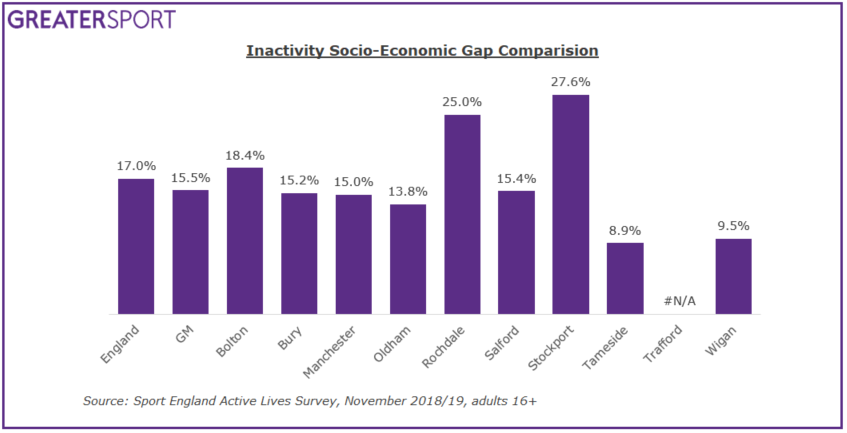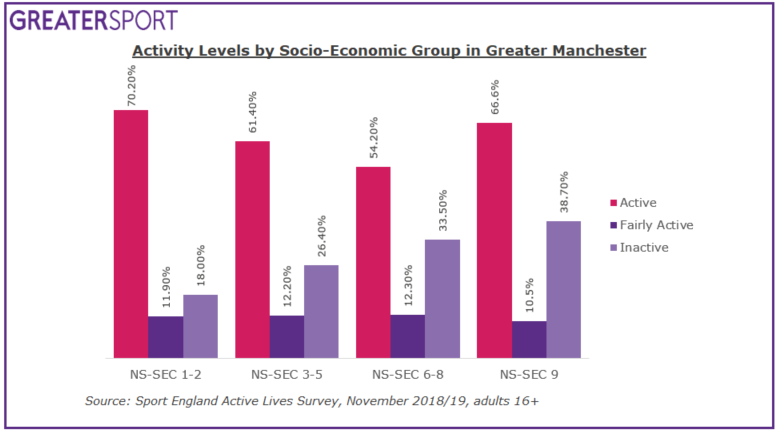Greater Manchester Activity Levels Nov 18-19: Socio-Economic Status
A detailed breakdown of the latest Active Lives research into the difference in activity levels across socio-economic groups in Greater Manchester. Overall the socio-economic inactivity gap in Greater Manchester is smaller than the national figure.
A number of inactivity inequality gaps exist and whilst they may have narrowed, to varying degrees, across Greater Manchester (GM) we can still see clear gender, age, disability, socio-economic status and ethnicity gaps. Many of these factors overlap and further compound the differences.
In the latest Active Lives release the socio-economic inactivity gap in GM is 15.5%, this is lower than the England gap where the figure is 17.0%. In GM the socio-economic inactivity gap has shrunk by 3.1% since baseline (November 2015/16) whereas nationally it has grown by 0.7%. Across GM there are noticeable differences between the ten boroughs with the gap varying from 8.9% in Tameside to 27.6% in Stockport and overall three of the boroughs have a wider inactivity gap than England.

Socio-Economic Groups: A breakdown
Inactivity levels for those in NS-SEC 6-8 (lower social groups) is almost double that of the inactivity levels of those in NS-SEC 1-2 (higher social groups), 33.5% compared to 18.0%. However, these vary significantly between the boroughs with NS-SEC 6-8 inactivity ranging from 29.2% in Tameside to 42.8% in Rochdale and NS-SEC 1-2 inactivity ranging from 19.8% in Trafford to 33.8% in Oldham.
Overall, activity levels increase with socio-economic status, the exception to this NS-SEC 9 (students and other non-classified persons) this group has, overall, the second highest activity levels. However when this is broken down into students and other it becomes clear that this is driven primarily by student activity levels, this is apparent when all socio-economic groups are broken down further and NS-SEC 9: Students sees the highest activity levels.

Socio-economic status and other factors
It is important to note that the gender inactivity gap varies dependent upon socio-economic grouping. The gender inactivity gap overall in Greater Manchester is 2.5%, however, amongst those from low socio-economic backgrounds (NS-SEC 6-8) the gap is 6.8%; with 36.8% of females inactive compared to 30% of males. Amongst NS-SEC 3-5 (middle socio-economic groups) the gender-socio-economic inactivity gaps is reversed, with women having lower rates of inactivity than men; 24.7% compared to 27.9%.
Deprivation: A breakdown
The most deprived areas in GM see the highest inactivity rates, 33.6%, however, the relationship between deprivation and inactivity is not completely linear. Whilst the 10% most deprived areas see the highest inactivity the least deprived 10% do not see the lowest levels of inactivity. However, the gap between the two is still great with the most deprived areas having inactivity rates over 1.5 times higher.

Sport England, through their Tackling Inactivity and Economic Disadvantage programme, offers further information on how to engage those from low socio-economic backgrounds in physical activity.
More information on the latest Active Lives release can be found here. Find out more about the relationship between socio-economic status and physical activity here.
